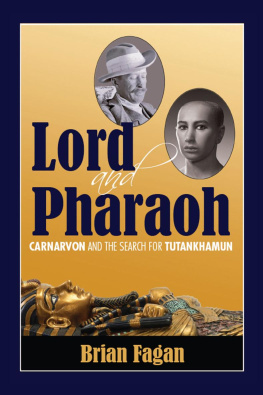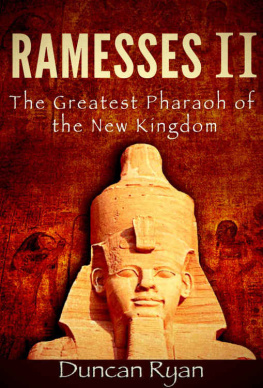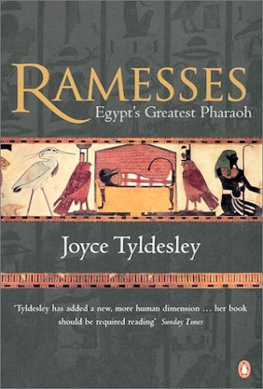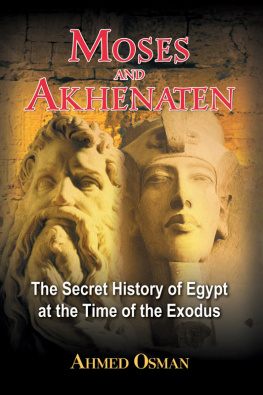Pharaoh Seti I
For Ingrid
Pharaoh Seti I
Father of Egyptian Greatness
Nicky Nielsen
First published in Great Britain in 2018
by Pen & Sword History
An imprint of Pen & Sword Books Limited
47 Church Street
Barnsley
South Yorkshire
S70 2AS
Copyright Nicky Nielsen 2018
ISBN 978 1 52673 957 5
eISBN 978 1 52673 959 9
Mobi ISBN 978 1 52673 958 2
The right of Nicky Nielsen to be identified as
Author of this Work has been asserted by him in accordance
with the Copyright, Designs and Patents Act 1988.
A CIP catalogue record for this book is
available from the British Library.
All rights reserved. No part of this book may be reproduced or transmitted in any form or by any means, electronic or mechanical including photocopying, recording or by any information storage and retrieval system, without permission from the Publisher in writing.
Pen & Sword Books Limited incorporates the imprints of Atlas,
Archaeology, Aviation, Discovery, Family History, Fiction, History,
Maritime, Military, Military Classics, Politics, Select, Transport,
True Crime, Air World, Frontline Publishing, Leo Cooper,
Remember When, Seaforth Publishing, The Praetorian Press,
Wharncliffe Local History, Wharncliffe Transport,
Wharncliffe True Crime and White Owl.
For a complete list of Pen & Sword titles please contact
PEN & SWORD BOOKS LIMITED
47 Church Street, Barnsley, South Yorkshire, S70 2AS, England
E-mail:
Website: www.pen-and-sword.co.uk
Contents
Map showing the major sites in Egypt during the reign of Seti I. ( Author )
Map of Upper and Lower Nubia. ( Author )
Map showing the principal locations and civilizations in the Near East during Setis reign. ( Author )
Plan of the Great Hypostyle Hall at the Karnak Temple in Luxor. ( Author )
Plan of Seti Is temple at Abydos. ( Author )
Plan of Setis mortuary temple at Qurna. ( Author )
Foreword
Seti, son of Paramessu, was a remarkable man. His biography reads like a blueprint for the ideal dynastic king. Born the son of a soldier, Seti had royalty thrust upon him when his elderly father was unexpectedly gifted the throne of Egypt. After just two years working as vizier and coregent alongside the renamed Ramesses I, Seti was himself crowned king of the Two Lands. He proved to be an ambitious and highly effective monarch: a successful warrior and an accomplished builder. Under his direct command, an aggressive series of military campaigns saw Egypts borders secured and Egypts military reputation, which had been somewhat tarnished during the Amarna Period and its immediate aftermath, restored to its former glory. Increased stability brought increasing wealth, which allowed Seti to finance a portfolio of ambitious construction projects throughout Egypt. The Temple of Re at Heliopolis, the Temple of Ptah at Memphis and the Temple of Amen at Karnak all benefited from his generosity. At the ancient cemetery site of Abydos, Seti built a unique monument: a subterranean cenotaph linked to an extensive temple whose seven sanctuaries were dedicated to the gods Osiris, Isis, Horus, Amen-Re, Re-Harakhty, Ptah and the deified Seti himself. On the west bank of the Nile, at Thebes, Seti erected a conspicuous memorial temple and, hidden in the nearby Valley of the Kings, he excavated the longest, deepest and most beautifully decorated of all the royal tombs.
After just over a decade on the throne, Seti, still a relatively young man by modern standards, died. As he had planned, his mummified body was buried in an elaborate alabaster sarcophagus in his extensive tomb. The rituals were performed, the tomb door was sealed and Setis spirit journeyed into the west, where he transformed from a semi-divine being into a god. Today, Setis mummy rests in Cairo Museum where his beautifully preserved head, brutally severed from his body by ancient tomb robbers, represents one of the finest examples of the dynastic embalmers art.
I hope that this brief biography is enough to convince the reader that Seti I is a man entirely worthy of detailed study. Why, then, has he been overlooked by historians? The blame lies to a great extent with his son, the much larger-than-life Ramesses II. Ramesses followed his father onto the throne, and ruled Egypt for an almost unbelievable sixty-six years. This gave him sufficient time to impose his name on the Egyptian landscape by both building his own monuments and blatantly borrowing the monuments and inscriptions of others. Ramesses cut his hieroglyphs larger and deeper than anyone else, so that by the time of his death his name was written large all over his land. A master of propaganda, he has been able to convince us that he, Ramesses, was and always would be Egypts greatest king. With Ramesses usurping the historical limelight, Seti, the man who laid down the foundations for his sons reign, has been condemned to stand hidden in shadow.
So I am delighted that Nicky Nielsen has undertaken the task of restoring Seti to his rightful place as of one of Egypts most successful kings. Setting Seti into his proper historical context, Dr Nielsen provides a scholarly, comprehensive and very readable guide through the intricacies of his family life, his reign and its immediate aftermath. His admiration for Seti and his achievements shines through his writing, making this book an essential read for anyone interested in the development of Egypts dynastic age.
Dr Joyce Tyldesley (archaeologist, author and Senior Lecturer in Egyptology at Manchester University), October 2017
Acknowledgements
First and foremost, I would like to thank my parents Gitte and Leif for their encouragement during the writing process and for imbuing me with a love of history which would eventually become a career. I should also like to thank Philip Sidnell, commissioning editor at Pen & Sword for his help and interest; Dr Joyce Tyldesley for sharing with me some of her wealth of experience as an author and scholar; Dr Huw Twiston Davies for tolerating endless conversations about Seti and his reign with good grace; Dr Campbell Price, Dr Gina Criscenzo-Laycock and Dr Valentina Gasperini for their kind encouragement and crucially, Diana T. Nikolova for being with me every step of the way with unconditional support and love.
Chronology of Ancient Egyptian History
| Predynastic Period | 53003000 BC |
















